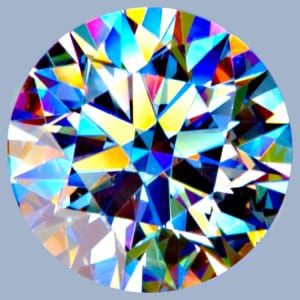Question: What exactly is the American Ideal? Was it Americans who refined the cutting/proportioning process?
The American Ideal Cut
Ideal is defined as:
“A standard of perfection, beauty, or excellence.”
The standard of perfection and beauty in diamond cutting is embodied in the round brilliant, American Ideal cut. This concept of an ideal cut for diamonds was adopted, and championed by both the GIA and the AGS for over half a century. Both organizations credited the Belgian diamond cutter and mathematician Marcel Tolkowsky (1899-1991) with the key design proportions of the American Ideal, (average pavilion and crown main angles of 40.75 and 34.5 degrees).
“THE QUEST FOR THE IDEAL”
The GIA diamond course from 1993, on the page titled “The Quest for the Ideal” points out: “Although Diamond Design was first published in England, Tolkowsky’s design is often called the American Ideal Cut, because US cutters were the first to adopt it. … For years, GIA used the American Ideal Cut as the basis of a comparison system in teaching diamond cut evaluation.”
Tolkowsky wrote of a breed of diamond cutter whose goal was to cut a diamond “regardless of loss of weight, the only aim being to obtain the liveliest fire and the greatest brilliancy.”Although not the first person to formulate proportions believed to result in maximal brilliance and fire, he is the one most people think of as the father of this ideal.
Tolkowsky’s findings became the basis for the American Ideal Cut. And his model for the best-performing round-brilliant diamond remains the most influential in history.
However a historical inaccuracy needs to be righted. Tolkowsky never called his diamond an “ideal cut.” He called it a “high-class brilliant,” meaning it had, in his words, “magnificent brilliancy and fire.” What’s more, he never said he invented his model for the round-brilliant diamond. His “Diamond Design” publication added mathematical support for the rightness of a model already in use. Its origin, he said, lies with others, including an almost forgotten mid-19th century Boston cutter named Henry Morse.
The beginnings of what came to be the American Ideal Cut diamond are traced to the pioneer of American diamond cutting, Henry Morse, who, in 1860, opened the first American diamond-cutting firm in Boston, Massachusetts.By 1880 he was recutting the traditional Old European cut diamond without regard for weight retention to produce the most beautiful round brilliant cut diamond of his time. (Morse’s model had a pavilion angle within a degree of 41 and a crown angle close to 35 degrees).
His work went largely unheralded because the great majority of diamond manufacturing in the US steadfastly followed traditional European cutting with the goal of maximum weight retention from the rough diamond crystal.
Since the times of Morse and Tolkowsky, cutters of the American Ideal have continued to improve its beauty by lengthening the lower-girdle facets and slightly increasing the table size–all the while staying close to Tolkowsky’s and Morse’s recommended average pavilion and crown angles (40.75,41 and 34.5,35).
During the 80’s, diamond cutters in Japan improved the physical and optical symmetry of the American Ideal cut using instruments that displayed the three-dimensional optical performance of all 57 facets of the round brilliant. The result was a new dimension in cutting perfection resulting in the optically symmetric ideal that today is called hearts and arrows due to the precise 8 rayed arrow and hearts pattern it displays..
Introduced in America in the 90’s, the optically symmetrical, hearts and arrows ideal was championed by several American diamond importers and cutting houses. The American Ideal continued to be refined by cutters using the latest diamond cutting technology and optical performance assessment tools.
The American Ideal cut diamond has evolved and improved in optical performance and beauty through the advancing skills and technology of the very best of the diamond cutting profession. Today, cutting firms worldwide are embracing the evolved American Ideal.
Begun in America with Henry Morse, championed by GIA and AGS, and nurtured by American cutters, this pinnacle of performance and beauty represents, in diamond cutting, the culmination of the quest for Ideal.
DIAMOND BEAUTY – BRILLIANCE, FIRE AND SPARKLE
Fire, which is diamond’s dispersion of light into rainbow colors is an important and desirable aspect of diamond beauty. It is a property of the American Ideal that is often overlooked, because the bright lighting in today’s jewelry stores usually emphasizes the other two aspects of diamond beauty— brilliance and sparkle.

This photograph of a hearts and arrows ideal is taken in special high contrast spot lighting to demonstrate the fire potential of the ideal cut.
The diamond’s fire is better observed in high contrast lighting. Lighting of this nature may be found in some restaurants, theatres, ballrooms, etc., where the illumination is mainly from spot lighting in otherwise low light surroundings. The prevalence of artificial lighting of this type from gas and kerosene lamps, candles, chandeliers, etc. better highlighted the fire aspect of the diamond’s beauty in times prior to the advent of modern, 20th century lighting. At that time, unlike today, fire was advertized as the diamond’s most important attribute.